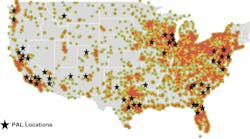Last year I wrote a column called “Time for Alternatives,” in which I said that the increasingly mercenary tactics of OPEC should encourage trucking fleets large and small to use alternative fuels. One option I discussed at the time was natural gas, an option one reader has since taken me to task over since it nearly quadrupled in price this winter.
While I admit that my ability as a market forecaster stinks, I think my original point is still valid: Since the U.S. is using greater quantities of imported oil, gasoline and diesel supplies could be jeopardized by the political whims of other countries. That's why I think fleets need to find another source of fuel — one that doesn't have Saddam Hussein, Iranian clerics, Saudi princes, Venezuelan colonels or Russian mobsters holding the keys to the pump.
This is where biodiesel comes in.
Biodiesel is actually a misnomer, because in its pure form it contains no diesel. The fuel is made from organic sources such as soybeans, vegetable oil and animal fat. According to Gene Gebolys, president of biodiesel maker World Energy Inc., there's an excess supply of large-scale vegetable oil refining in this country. So there are no real production and distribution limitations for this fuel.”
The real clincher with biodiesel, however, is that it requires no engine retrofits or extra technology; you literally put it in the fuel tank and go.
I know that many engineering details still need to be ironed out, but biodiesel is already being used in a variety of trucking applications, from trash trucks in San Jose to school buses in Arizona. And it's been used in Europe for over 20 years. Making it work for light- and medium-duty fleets, many of which get fuel from a central location, may be easier than you think.
Right now, it's only about 10¢ to 15¢ more per gallon than diesel — and with OPEC in charge, that could change very quickly.
With sulfur content at zero, biodiesel is about as environmentally friendly as you can get. It's also 11% oxygenated by weight so it burns cleaner. Pure biodiesel cuts particulate matter by 30%, carbon monoxide by 50% and hydrocarbon emissions by 93%. As a blend called B20 (20% biodiesel, 80% diesel), it cuts those emissions by 22%, 20% and 30% respectively. Only oxides of nitrogen (NOx) show an increase with both pure and blended biodiesel — 13% and 2%, respectively. Table salt is more toxic than this stuff. Its flashpoint is 300 deg. F, much higher than diesel's 125 deg. F. And on top of all that, it's an excellent lube for engines.
There are some drawbacks, of course. In its purest form, biodiesel has a cloud point of 25 deg. F, so it's not a good fuel for trucks operating in extremely cold environments. When blended with regular diesel, however, the cloud point improves significantly: A B20 blend drops the cloud point to between 3 and 5 deg. F.
Pure biodiesel can also degrade some elastomer and natural or butyl rubber components in truck engines, such as fuel hoses and fuel pump gaskets. While many engine makers have said B20 blends will not void product warranties, most have not extended that guarantee to pure biodiesel. It's not a cure-all, but biodiesel seems to be positioned as a good replacement for diesel in specific niches, especially warm-weather ones.
As we deal with ever-rising fuel prices, biodiesel may be the only alternative that can step in as a replacement on short notice and in significant quantities. As Gebolys says, “We have to do more to break the grip petroleum has on our country's transportation system — and this is a fuel that can help us do that.”


